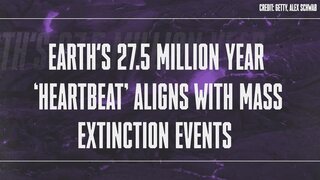Create a free profile to get unlimited access to exclusive videos, sweepstakes, and more!
Earth's 27.5 million year 'heartbeat' aligns with mass extinction events

In a new updated study that SYFY WIRE first put the stethoscope to back last year, scientists at New York University have elaborated on their initial research showing that our Earth exhibits a geologic "heartbeat" that pulses at regular intervals every 27.5 million years.
In their latest report published June 17 in the online journal Geoscience Frontiers, NYU’s team of geologists and biologists found more evidence that pivotal events in Earth’s more recent history have congregated around Earth-shattering patterns over the past 260 million years.
These dozens of epic geologic events range from major crust upheavals, sea-level shifts, volcanic eruptions, earthquakes, and more.
"For quite a long time, some geologists have wondered whether there's a cycle of around 30 million years in the geologic record," lead author Michael Rampino, a professor in the departments of biology and environmental studies at New York University, told Live Science. “But until recently, poor dating of such events made the phenomenon difficult to study quantitatively.
"Many, but maybe even most, [geologists] would say that geological events are largely random.”
In this expanded study, Rampino and his crew engaged in quantitative analysis to determine whether or not these cataclysms were strictly random or if there existed some sort of clustered pattern.
After poring over data and identifying 89 primary geological occurrences that happened in the past 260 million years, the team began to see a rhythm. These events included, but were not limited to, extinction-level events, toxic ocean cycles caused by oxygen depletion, sea-level fluctuations, violent flood-basalt eruptions, and shifts in the orientation of Earth's tectonic plates.
By arranging the glaring examples in chronological order and employing a mathematical tool called a Fourier analysis, Rampino and company witnessed spikes in the frequency of events.
A majority of these events throbbed 10 separate times that raged on an average of 27.5 million years apart. Those numbers represent a respectable estimate of non-coincidental happenings paired with a 96% confidence interval.
They also performed a similar Fourier transform analysis of the combined records of 12 marine extinctions and nine non-marine tetrapod extinctions over the last 260 million years, which represent 21 total extinction events and saw this same 27.5 million year number popping up repeatedly.
The NYU researchers believe that these patterns could be traced back even further to roughly 600 million years ago for even greater pattern recognition, especially when it came to marked sea level changes.
Exactly why these repetitive pulses are occurring within the still-evolving planet, scientists are not exactly sure, but it’s thought that it might be a consequence of internal plate tectonics and movement inside the mantle.
Another hypothesis is some sort of cosmic clock revolving around the movement of Earth amid the solar system and the Milky Way galaxy. Per their research paper, something that helps support their findings shows that this 27.5 million year "heartbeat" is surprisingly near our Big Blue Marble’s 32 million year vertical oscillation around the midplane of the galaxy.
“One theory is that the solar system sometimes moves through planes containing larger amounts of dark matter in the galaxy,” Rampino added in his chat with Live Science. “When the planet moves through dark matter, it absorbs it; large amounts of captured dark matter can annihilate and release heat, which can produce a pulse of geological heating and activity. Perhaps this interaction with large amounts of dark matter correlates with the pulse of the Earth.”



























